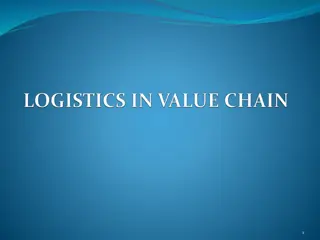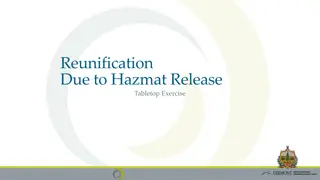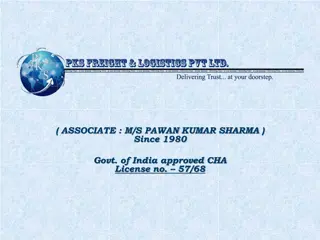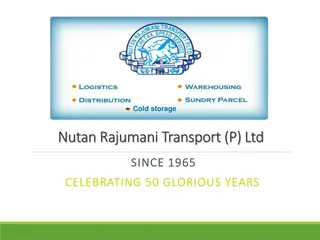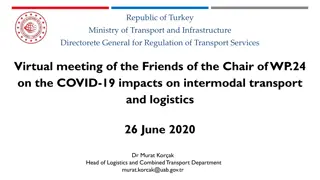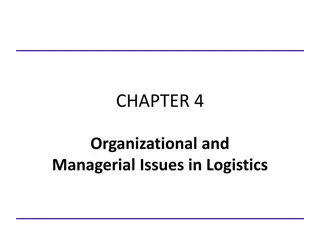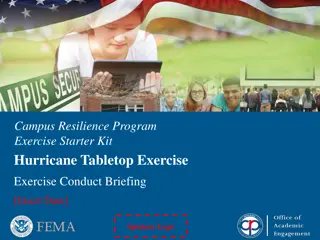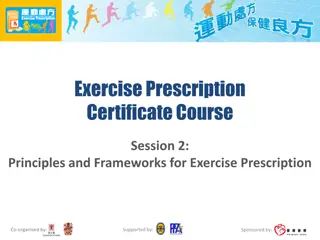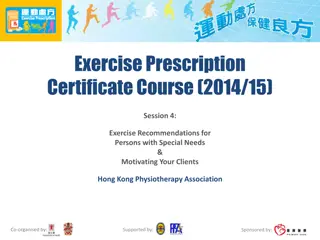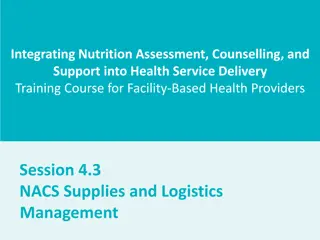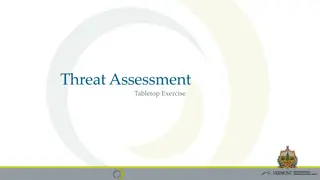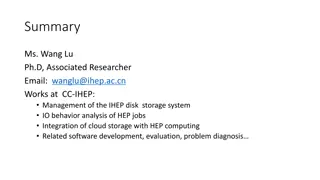Mewong Exercise Task 2: Transport and Storage Logistics Overview
The Mewong Exercise Task 2 involves analyzing storage needs and planning transport logistics in designated hub locations. As the Logistics officer, you will calculate required storage capacity, develop a road transport plan, and coordinate supply chain arrangements to facilitate efficient humanitarian cargo transit. Get ready to tackle tasks related to storage dimensioning, transport planning, and warehousing coordination to ensure successful disaster response efforts.
Download Presentation

Please find below an Image/Link to download the presentation.
The content on the website is provided AS IS for your information and personal use only. It may not be sold, licensed, or shared on other websites without obtaining consent from the author. Download presentation by click this link. If you encounter any issues during the download, it is possible that the publisher has removed the file from their server.
E N D
Presentation Transcript
Mewong Exercise TASK 2: Transport and Storage WFP Logistics, We Deliver
Lesson Objectives By the end of this lesson, you will be able to: Analyse needs and calculate the required storage structures in 2 logistics hub in Mewong 1 Develop a basic road transport plan from the capital to 2 logistics hub in Mewong 2
Mewong Exercise Task 2: Overview The response effort has started You have been deployed in Nakhon and you are the Logistics officer. 2 basic government offices are already set in Nakohn and Negeri but will have to install Mobile Storage Units (MSUs) to augment the capacity. You just received the details of the operation. Nakhon and Negeri have been choosen as logistics hub locations where the humanitarian cargo will transit. You are tasked with the the dimensioning of the storage and the planning of the transport. Presentation exercise : 10 min Timing Exercise: 110 min Debriefing: 60 min The hand-outs 4 and 7 contain all the information you need for this exercise. Handout
Mewong Exercise Task 2: Scenario details Please refer to the handout 6 (Mewong exercise task 2 Transport and storage) and, considering the Supply chain coordination, transport and warehousing arrangements. Your objectives are: 1. Given the cargo to be received, estimate the storage capacity needed in Nakhon (NK) and in Negeri (NG). 1. Plan the transport of tents, family kits and a two weeks stock of rice to be prepositioned and readied for the first round of distributions in Nakhon (NK) and in Negeri (NG).
Mewong Exercise Task 2: Scenario details Your task is to answer those questions: 1. How many tents and family kits will you store in NK and NG? 1. What is the number of MSU s required for storage at NK and NG? 1. Plan the transport for all supplies: From Meo to Nakhon, using 50 x 40MT trucks From Nakhon to Negeri, using 60 x 10 MT trucks
Mewong Task 2: Operational map review Entry corridor Primary transport road Secondary transport road
Mewong Exercise Task 2: Transport and Storage Solutions
Mewong Exercise Task 2: Question 1 Solution Inputs from Handout 4 To define the dimensions of the storage one has to first define how the first 5000 tents and the first 10,000 kits should be split between NK and NG: Number of households in needs of family kits (%) Number of households in needs of family shelter Shelter Proportion (%) Number of tents to be stored per location Number of family kits to be stored per location Fam.kits Proportion Province S-West? (NK) 66,000 47% 2,350 100,000 45.5% 4,550 South? (NG) ? Total 75,000 141,000 53% 2,650 5,000 120,000 220,000 54.5% 100.0% 5,450 10,000 100.0% Conclusion: Out of the 5000 tents, 2,350 will go to NK while 2650 tents will go to NG Out of the 10,000 family kits, 4,550 will go to NK while 5450 family kits will go to NG.
Mewong Exercise Task 2: Question 2 Solution Input from Handout 4 To calculate the space needed for the Tents (t) and the Kits (k), we consider the number of items and multiply them by the given volumes (V): In NK: V(t) = 2,350 x 0.18 = 423 cbm and V(k) = 4,550 x 0.12 = 546 cbm In NG: V(t) = 2,650 x 0.18 = 477 cbm and V(k) = 5,450 x 0.12 = 654 cbm To calculate the space needed for the rice (r), we consider the number of beneficiaries per region, the weight of the daily ration per person (600gr = 0.6Kg), the number of days the rations must be stored for (0.5 month = 15 days) and the volume of the rice when stored in bags (1 MT = 1.5 cbm). Remember that Kg should be converted in MT. In NK: V(r) = (450,000 x 15 x 0.6)/1000 x 0.5 = 4,050 (MT) x 1.5 = 6,075 cbm In NG: V(r) = (350,000 x 15 x 0.6)/1000 x 0.5 = 3,150 (MT) x 1.5 = 4,725 cbm
Mewong Exercise Task 2: Question 2 Solution To recap: MSU capacity NFI Number of MSUs MSU capacity Number of MSUs Tents kits Total NFI storage (70%) needed for NFIs rice NFI storage needed for NFIs Total MSU Need per Province (cbm) (cbm) (cbm) (cbm) (standard unit) (cbm) (70%) (cbm) (standard unit) location S-West? (NK) 423 546 969 336 2.9 6,075 504 12 15 South? (NG) 477 654 1,131 336 3.4 4,725 504 9 13 Storage needs are therefore: In NK, we need 15 MSUs In NG, we need 13 MSUs (All MSUs are standard in dimensions: 24 m x 10 m)
Mewong Exercise Task 2: Question 3 Solution Travel times and dispatch plan overview: The transport will be planned in 2 legs. Leg 1: From Meo to NK, taking 3 days return trips, 50 trucks (40 MT maximum capacity each) will transport the tents allocated to NK and NG and the rice allocated to NK and NG. The family kits (considered delivered in NK) will be stored in NK. The family kits allocated to NG will be transported to NG by 10 MT trucks. Leg 2: In NK, the rice and the tents to NG will be transshipped onto 10 Mt trucks. The cargo to NG will be consolidated with the family kits. All cargo to NG, will be transported by 60 trucks (10 MT capacity each) from NK to NG. Trucks will complete every rotation to NG in one day (return trips).
Mewong Exercise Task 2: Question 3 Solution Data calculated in Question 2 Total cargo to NK: V (tents to NK) = 423 cbm V (tents to NG) = 477 cbm V (kits to NK) = 546 cbm V (kits to NG) = 654 cbm W (rice to NK) = 4,050 MT W (rice to NG) = 3,150 MT Inputs from Handout 4 Number available 60 50 Capacity 10MT 40MT Volume 40 CBM 120 CBM Feeder trucks Highway trucks According to the given figures above (Handout 4) the trucking fleet can be calculated as follow:
Mewong Exercise Task 2: Question 3 Solution Leg 1 Plan From Meo to Nakhon: The total cargo (40 MT trucks) from Meo to NK (Transport leg 1) is: Tents (NK+NG) + Rice (NK+NG) = (423 cbm + 477 cbm = 900 cbm) + (4,050 MT + 3,150 MT = 7200 MT) Day 1: Number of truck for tents = 900 / 120 = 7.5 Number of trucks for rice = 50 7.5 = 42.5 7 trucks will leave with tents only (7 x 120 cbm = 840 cbm) while 42 trucks will leave with rice only (42 x 40 MT = 1680 MT). 1 truck will leave with both tents and rice. Shared cargo calculation: Half a load of rice is 20 MT, which uses only 20 x 1.5 = 30 cbm (leaving 90 cbm for tents) Half a volume of tents is 60 cbm, which weights (60 / 0.18) x 54 /1000 = 18 MT Total weight of the mixed cargo = 20 +18 = 38 MT Total volume of the mixed cargo = 30 + 60 = 90 MT Total volume of tents transported on day 1 = 840 cbm + 60 cbm = 900 cbm Balance of tents to be transported to NK = 0 Total weight of rice transported on day 1 = 1680 MT + 20 MT = 1700 MT Balance of rice to be transported to NK = 7200 1700 = 5500 MT
Mewong Exercise Task 2: Question 3 Solution Leg 1 Plan From Meo to Nakhon: Day 4 (3 days after day 1): 50 trucks leave with 40 MT of rice Total weight transported on day 4 = 2000 MT Balance of rice to be transported to NK = 5500 2000 = 3500 MT Day 7 (3 days after day 4): 50 trucks leave with 40 MT of rice Total weight transported on day 7 = 2000 MT Balance of rice to be transported to NK = 3500 2000 = 1500 MT Day 10 (3 days after day 7): Number of trucks needed to complete the transport of rice to NK = 1500 / 40 = 37.5 = 38 trucks Leg 1 Meo to NK - Recap table: Transport? planning Meo? ->? NK (1? rotation/3? days) Weight? to? be? transported? (MT) Volume? to? be? transported? (cbm) No.? of? 40MT? trucks Balance? to? be? transported Balance? to? be? transported Rotation? departure? day Tents Fam.kits Rice Tents Fam.kits Rice Per? weight Per? volume D1 1700 5500 900.00 0.00 42.5 7.5 D4 2000 3500 50 D7 2000 1500 50 D10 1500 37.5 Total? to? be? transported 7200 900
Mewong Exercise Task 2: Question 3 Solution Data calculated in Question 2 Total cargo to NG: V (tents to NG) = 477 cbm V (kits to NG) = 654 cbm W (rice to NG) = 3,150 MT According to the given figures above (Handout 4) the trucking fleet can be calculated as previously:
Mewong Exercise Task 2: Question 3 Solution Leg 2 Plan From Nakhon to Negeri: The total cargo (10 MT trucks) from NK to NG (Transport leg 2) is: Tents NG + Family kits NG + Rice NG = 477 cbm + 654 cbm + 3150 MT Note: The transport from NK to NG only starts on day 3 as the cargo from Meo only arrives in NK on Day 2. Leg 2 NK to NG - Recap table (planned as in Leg One): Transport? planning NK? ->? NG (1? rotation/1? days) Weight? to? be? transported? (MT) Volume? to? be? transported? (cbm) No.? of? 10MT? trucks Balance? to? be? transported Balance? to? be? transported Rotation? departure? day Tents Fam.kits Rice Tents Fam.kits Rice Per? weight Per? volume D3 317.25 2832.75 477.00 654.00 0.00 31.725 28.275 D4 600 2232.75 60 D5 600 1632.75 60 D6 600 1032.75 60 D7 600 432.75 60 D8 432.75 43.275 Total? to? be? transported 3150 477 654
Questions WFP Logistics, We Deliver



